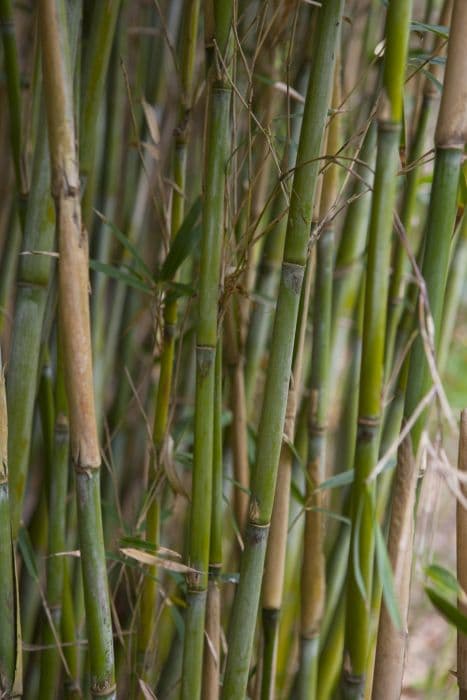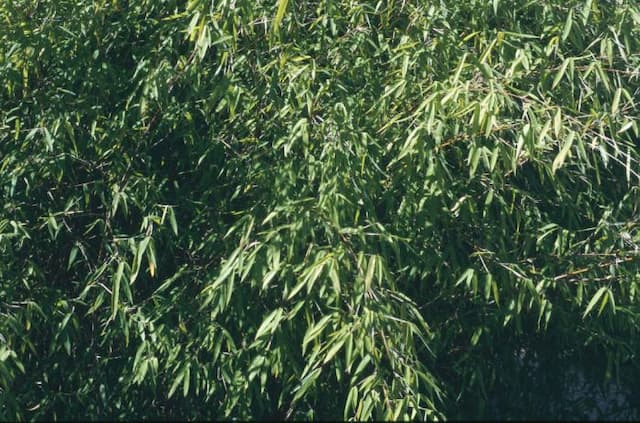Pampas Grass Cortaderia selloana 'Albolineata' (v)

ABOUT
The plant commonly known as Pampas Grass 'Albolineata' sports a striking and elegant appearance with its long, arching leaves. These leaves are particularly notable for their variegated coloring, featuring a creamy white strip that runs down the center, flanked by green edges that provide a lush contrast. The variegated foliage creates a striking visual texture and can add interest to garden spaces with its longitudinal stripes. During the plant's blooming season, it produces towering, feathery plumes which are often silvery-white. The plumes appear above the foliage and have a fluffy, feather-like appearance, giving the plant a soft, ethereal quality. These plume-like inflorescences are one of the most distinctive features of Pampas Grass 'Albolineata', and they contribute significantly to its popularity as an ornamental grass. The plant's overall form is dense and fountain-like, with the foliage and flower plumes gently spilling outwards from the center. This growth habit adds to its visual impact, making it a focal point in garden designs. The combination of its variegated leaves and delicate inflorescences makes Pampas Grass 'Albolineata' a highly decorative plant that can complement a variety of garden styles and landscapes.
About this plant
 Names
NamesSynonyms
Variegated Pampas Grass, Silver Stripe Pampas Grass, Variegated Silver Grass
Common names
Cortaderia selloana 'Albolineata'
 Toxicity
ToxicityTo humans
Pampas Grass is not considered toxic if ingested by humans. However, it is important to note that the leaves and stems of Pampas Grass can cause physical irritation due to their sharp edges. Contact with the plant's foliage or plumes might result in cuts or dermatitis. There are no recognized toxic effects from eating any part of Pampas Grass.
To pets
Pampas Grass is also not toxic to pets if ingested. Similar to humans, the physical structure of Pampas Grass can cause irritation or injury due to the sharp edges of the leaves. If pets consume the plant or come into contact with it, they may experience cuts or irritation in or around their mouth or skin, but not poisoning from ingestion.
 Characteristics
CharacteristicsLife cycle
Perennials
Foliage type
Evergreen
Color of leaves
Variegated
Height
6 feet (1.8 meters)
Spread
4 feet (1.2 meters)
Plant type
Grass
Hardiness zones
8
Native area
South America
Benefits
 General Benefits
General Benefits- Ornamental Appeal: Adds visual interest to gardens with its striking variegated foliage and large, feathery plumes.
- Low Maintenance: Requires minimal care once established, making it a practical choice for low-maintenance landscaping.
- Drought Tolerance: Can survive with limited water, ideal for xeriscaping and regions with water restrictions.
- Privacy Screen: Grows tall and dense, providing a natural privacy screen or windbreak in landscape designs.
- Soil Stabilization: Its root system can help prevent soil erosion on slopes and banks.
- Wildlife Habitat: Provides shelter and nesting material for birds and can be a food source for some species.
- Year-Round Interest: Offers aesthetic appeal throughout the year, including during winter when other plants may be dormant.
- Adaptability: Can thrive in a variety of soil types, from sandy to clay, as long as there is good drainage.
 Medical Properties
Medical PropertiesThis plant is not used for medical purposes.
 Air-purifying Qualities
Air-purifying QualitiesThis plant is not specifically known for air purifying qualities.
 Other Uses
Other Uses- Craft Material: The feathery plumes of Pampas Grass are commonly used in flower arrangements, wreaths, and other craft projects for a natural, textured look.
- Privacy Screen: Growing Pampas Grass in a row can create a natural and tall privacy screen for your garden due to its dense foliage and height.
- Sonic Insulation: Dense plantings of Pampas Grass can help reduce noise pollution by acting as a sound barrier in urban and suburban settings.
- Erosion Control: Pampas Grass can be planted on slopes or areas prone to erosion to help stabilize soil with its deep root system.
- Landscape Design: The variegated leaves of 'Albolineata' provide contrast in garden landscapes, making it a popular ornamental grass for aesthetic enhancement.
- Thematic Decorations: During Halloween and autumn celebrations, Pampas Grass is often incorporated into seasonal decor both indoors and outdoors.
- Wind Indicator: Due to its tall and responsive plumes, Pampas Grass is sometimes used in open spaces as a wind direction indicator.
- Wildlife Habitat: Though not native to all regions, Pampas Grass can provide shelter to certain small animals and birds within its dense foliage.
- Photo Shoot Prop: Its dramatic appearance makes Pampas Grass a popular backdrop for photographers during portrait or fashion photo shoots.
- Theatrical Scenery: Dried Pampas Grass can be used in stage design to add texture and a sense of wilderness to the theatrical scenery.
Interesting Facts
 Feng Shui
Feng ShuiThe Pampas Grass is not used in Feng Shui practice.
 Zodiac Sign Compitability
Zodiac Sign CompitabilityThe Pampas Grass is not used in astrology practice.
 Plant Symbolism
Plant Symbolism- Beauty: The Cortaderia selloana 'Albolineata', commonly known as the variegated pampas grass, has striking plumes and variegated leaves that symbolize natural beauty and gracefulness.
- Elegance: With its tall and flowing appearance, pampas grass is often associated with elegance and is commonly used in decorative arrangements for this reason.
- Resilience: Pampas grass can thrive in a variety of environments and represents the ability to adapt and persevere through different circumstances.
- Privacy: Because it can grow to large sizes and create dense clusters, pampas grass is symbolic of privacy and is often planted to screen views.
- Fertility: Traditionally, some cultures view pampas grass as a symbol of fertility because of its prolific seed production and fast growth.
- Wealth: The lush and full appearance of pampas grass plumes can symbolize wealth and abundance.
 Water
WaterPampas Grass, commonly referred to by its species name Cortaderia selloana, should be watered deeply to encourage root growth, allowing the soil to dry out slightly between waterings. During the growing season, watering once a week with about 1 to 1.5 gallons per plant should suffice, depending on the climate and soil moisture levels. Over the winter, reduce watering to every couple of weeks, provided there is no significant rainfall. In very hot weather, you may need to water twice a week to prevent the soil from drying out completely.
 Light
LightPampas Grass thrives best in full sun conditions, receiving at least 6 to 8 hours of direct sunlight daily. It is best placed in a spot where it can enjoy unfiltered sunlight throughout the day. Partial shade is tolerated but may result in reduced growth and fewer plumes.
 Temperature
TemperaturePampas Grass is hardy and can endure a wide range of temperatures, with an ideal growing range between 70 to 80 degrees Fahrenheit. It can survive minimum temperatures down to roughly 20 degrees Fahrenheit but performs best when not subjected to prolonged periods of extreme cold.
 Pruning
PruningPrune Pampas Grass in late winter or early spring before new growth begins. Pruning is essential to remove old foliage and make room for fresh growth, enhancing the plant's appearance and health. It is typically cut back to about a foot above the ground annually.
 Cleaning
CleaningAs needed
 Soil
SoilPampas Grass prefers well-draining soil with a neutral to slightly acidic pH between 6.0 and 7.5. A mix containing loamy soil amended with compost and perlite or sand to improve drainage is ideal. Regular feeding with a balanced fertilizer will support its growth.
 Repotting
RepottingPampas Grass is a large perennial that typically does not require frequent repotting. If grown in containers, it can be repotted every 2 to 4 years to refresh the soil or if it has outgrown its current pot.
 Humidity & Misting
Humidity & MistingPampas Grass is tolerant of a wide range of humidity levels and does not have specific humidity requirements. It can thrive in both dry and humid conditions as long as it is planted in well-draining soil and receives adequate water.
 Suitable locations
Suitable locationsIndoor
Provide full sun, well-draining soil mix and water deeply.
Outdoor
Plant in full sun, in well-drained soil; drought-tolerant once established.
Hardiness zone
7-11 USDA
 Life cycle
Life cycleThe plant commonly known as Pampas Grass 'Albolineata' begins its life cycle when its seeds germinate in spring or early summer, requiring well-drained soil and full sun exposure to thrive. Seedlings emerge and develop into tufted clumps of arching, green and white variegated leaves. As the grass matures, typically within the second year, it sends up tall flower plumes that can reach several meters high; these plumes are initially white or silvery and may turn beige or pale brown as they age. The flowering stage occurs in late summer to early autumn, and the flowers are wind-pollinated. After pollination, seeds form and are dispersed by wind or wildlife. Pampas Grass 'Albolineata' is a perennial plant, so it will return yearly from its robust root system, with the life cycle repeating and the plant continuing to grow in size for several years.
 Propogation
PropogationPropogation time
Spring-Early Summer
Cortaderia selloana 'Albolineata', commonly known as Variegated Pampas Grass, is typically propagated through division, which is the most popular method for this ornamental grass. Propagation by division should ideally be carried out in late winter or early spring before new growth begins. To propagate, carefully lift the parent plant from the ground using a spade, ensuring you have a large root ball. Then, using a sharp knife or a spade, divide the root mass into sections, each with several shoots and a portion of the root system. Replant the sections at the same depth they were growing before and water thoroughly. This process stimulates new growth and helps maintain the variegation in the foliage.









